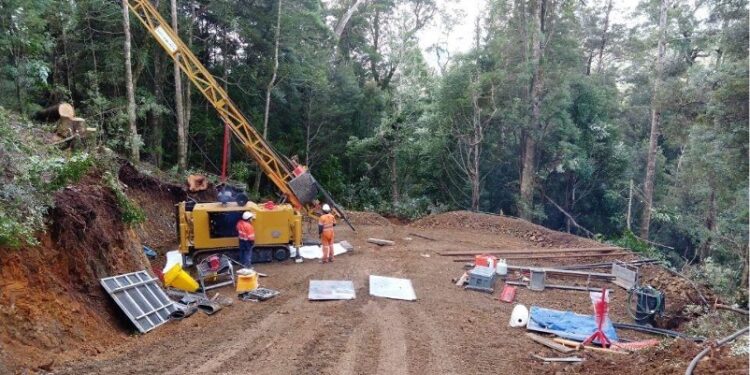Venture Minerals Limited’s (ASX: VMS) new drilling at the Mount Lindsay Tin-Tungsten Project, targeting high grade zones within the existing deposit, continues to return substantial intersections of high grade mineralisation with 147m @ 1.0% Sn and 0.2% WO3 from 90 m and still open down the hole awaiting further assay results.
The intersection in ML340M included a high grade zone of 45 m @ 2.5% Sn and 0.3% WO3 from 93 m or 9 m @ 5.9% Sn and 0.3% WO3 from 183 m.
The drill programme, designed to confirm the continuity of high grade zones and provide additional metallurgical samples, is part of the company’s updated Feasibility Study for an underground mine.
The significant intersections from ML339M included the following:
• 147 m @ 1.0% Sn and 0.2% WO3 or 1.2% Sn Eq from 90 m including
• 114 m @ 1.2% Sn and 0.2% WO3 or 1.5% Sn Eq from 93 m, or
• 99 m @ 1.4% Sn and 0.2% WO3 or 1.6% Sn Eq from 93 m, or
• 45 m @ 2.5% Sn and 0.3% WO3 or 2.9% Sn Eq from 147 m, or
• 9 m @ 5.9% Sn and 0.3% WO3 or 6.2% Sn Eq from 183 m.
Managing Director Andrew Radonjic, said Venture continues to drill additional holes on the Main Skarn’s High Grade MacDonald Shoot, this will be followed by similar targeted drilling on the No. 2 Skarn’s High Grade Radford Shoot.
“This new drilling at Mount Lindsay, focused on the high-grade zones, is starting to unveil the exceptional value that Mount Lindsay truly holds,” he said.
“At current metal prices, this 147 metre drill intersection has an average recovered value of A$680 per tonne, taking into account metallurgical recovery test work from our previous feasibility study. This high value per tonne makes Mount Lindsay a very attractive proposition for underground mining.”
The preliminary assay results for ML340M, as for ML339M, were from a nearby laboratory that generated results using a similar analytical technique for some of the suite of elements that are routinely assayed for on Mount Lindsay drill core.
The pulps will now be submitted to the preferred laboratory to provide assays for the missing elements and to check the values reported here using the analytical method chosen for the JORC compliant resource.
The underground Feasibility Study will advance previous scoping study work and includes additional drilling (currently in progress) to further confirm the continuity of the High-Grade MacDonald (named after Tom MacDonald, who discovered the Main Zone at Mount Lindsay in 1909) .
Current drilling will also provide material for finalising a cost effective, gravity-focused, processing flowsheet to concentrate the high-density minerals cassiterite (tin oxide – 79% Sn) and scheelite (81% WO3).
Additional work will include further detailed engineering studies to firm up the mine design and updating of the permit to reflect the change in mining and processing strategies.
The company is in the process of building a dedicated team to manage the Study program and will update shareholders as carefully selected individuals with strong backgrounds in the development of base metals assets in Australia with a focus on Tin and/or Tungsten, join the group.
The Mount Lindsay Project is already classified by the Australian Government as a Critical Minerals Project2 with an advanced Tin-Tungsten asset, which is significantly enhanced by the recent discovery of two new skarn zones, one within the Renison Mine Sequence in the Mount Lindsay area and the other along strike from Mount Lindsay’s main tin deposits.
For further information please visit: https://www.ventureminerals.com.au/












